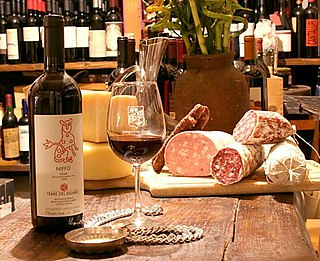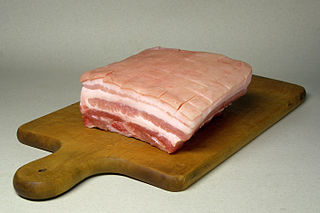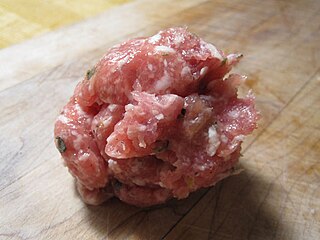
Ham sausage is a sausage prepared using ham and other ingredients, the latter varying by location. It is a part of the cuisines of China, Germany, Poland and the United States. Ham sausage is a mass-produced food product.

Ham sausage is a sausage prepared using ham and other ingredients, the latter varying by location. It is a part of the cuisines of China, Germany, Poland and the United States. Ham sausage is a mass-produced food product.

Autoclaved ham sausage is branded as "Ham Sausage" in China. [1] Ham sausage is mass-produced and consumed in China, and several varieties of the product exist in the country. [2] [3] The Chinese ham sausage is a mixture of meat and starch, as well as low concentrations of water, vegetable oil, salt, monosodium glutamate and other food additives. [4] A very small amount of ham sausage produced in China is exported to Japan (around .02% in 2004). [lower-alpha 1] The Chundu Group is an example of a Chinese company that produces ham sausage. [6]

In German cuisine, ham sausage (Schinkenwurst) is made from ham mixed with varying amounts of bacon, ground pork, beef, meat trimmings, garlic, and spices. [7] [8] [9] [10] The mixture is stuffed into casings, can be smoked, and is cooked in scalding or boiling water. [7] [8] Ham sausage can be cured using a curing solution that is rubbed into the ham, and machines can perform this process. [11] Ham sausage has a marbled appearance due to the ham and bacon pieces in it, which can be observed when the product is sliced. [7] [12] German ham sausage can be sliced and then grilled or fried, and is also used as an ingredient in soups and stews. [7]
Soppressata is an Italian dry-cured salami that is sometimes prepared using ham. [13]
Kielbasa szynkowa is a Polish ham sausage prepared using ham, pork shoulder, beef and spices. [14] [15] It can be prepared by hot smoking. [14]
The Christian Klinck Packing Company, established around 1868 in Buffalo, New York, by German immigrants, sold a ham sausage and other sausage products by 1905. [16] [17] [18] During the 1910s the Edelweiss brand included ham sausage in its product line. [19] In the late 1800s in the U.S., Parisian ham sausage was prepared using pork ham or shoulder, beef and spices. [12] [20] Parisian ham sausage at this time was smoked and then boiled. [20]
Smithfield Foods, an American [21] meat processing company, introduced ham sausage as part of its product line in the late 1970s. [lower-alpha 2] Sales projections for Smithfield Foods ham sausage were estimated to be 12,000 pounds (5,400 kg) per month when the sausage was introduced, and average sales thereafter of 38,000 pounds (17,000 kg) per month exceeded the initial estimate. [22]
New England ham sausage, also referred to as pressed ham, is prepared using ham or pork shoulder trimmings, and lean pork that is ground, smoked and then boiled. [lower-alpha 3]
Ham sausage is a mass-produced food. The Tai Foong Canned Goods Co. in Shanghai, China, produced and purveyed canned corned ham sausage and canned smoked ham sausage as early as 1915. [24] The Tianjin Meat United Processing Factory in Tianjin, China, produces Yingbin brand ham sausage in contemporary times. [3] [25] G.A. Müller and Könecke are German companies that produce a ham sausage called Schinken Bockwurst (English: ham bockwurst) and other sausage products in contemporary times. [26] Smithfield Foods of the U.S. has mass-produced ham sausage. [22]

Ham is pork from a leg cut that has been preserved by wet or dry curing, with or without smoking. As a processed meat, the term ham includes both whole cuts of meat and ones that have been mechanically formed.

Spam is a brand of processed canned pork and ham made by Hormel Foods Corporation. It was introduced in 1937 and gained popularity worldwide after its use during World War II. By 2003, Spam was sold in 41 countries on six continents.

A sausage is a type of meat product usually made from ground meat—often pork, beef, or poultry—along with salt, spices and other flavourings. Other ingredients, such as grains or breadcrumbs, may be included as fillers or extenders.

Breakfast sausage is a type of fresh sausage, typically made from pork, that is a common breakfast food in the United States. In the United States, the predominant flavorings used for seasoning are black pepper and sage. There are also varieties seasoned with maple syrup or cayenne pepper. Some breakfast sausage is flavored with cured bacon.

The origins of meat preservation are lost to the ages but probably began when humans began to realize the preservative value of salt. Sausage making originally developed as a means to preserve and transport meat. Primitive societies learned that dried berries and spices could be added to dried meat. The procedure of stuffing meat into casings remains basically the same today, but sausage recipes have been greatly refined and sausage making has become a highly respected culinary art.

Charcuterie is a branch of French cuisine devoted to prepared meat products, such as bacon, ham, sausage, terrines, galantines, ballotines, pâtés, and confit, primarily from pork.

Slovenian cuisine is influenced by the diversity of Slovenia's landscape, climate, history and neighbouring cultures. In 2016, the leading Slovenian ethnologists divided the country into 24 gastronomic regions. The first Slovene-language cookbook was published by Valentin Vodnik in 1798.

Curing is any of various food preservation and flavoring processes of foods such as meat, fish and vegetables, by the addition of salt, with the aim of drawing moisture out of the food by the process of osmosis. Because curing increases the solute concentration in the food and hence decreases its water potential, the food becomes inhospitable for the microbe growth that causes food spoilage. Curing can be traced back to antiquity, and was the primary method of preserving meat and fish until the late 19th century. Dehydration was the earliest form of food curing. Many curing processes also involve smoking, spicing, cooking, or the addition of combinations of sugar, nitrate, and nitrite.

Salumi are Italian meat products typical of an antipasto, predominantly made from pork and cured. Salumi also include bresaola, which is made from beef, and some cooked products, such as mortadella and prosciutto.

Pork is the culinary name for the meat of the pig. It is the most commonly consumed meat worldwide, with evidence of pig husbandry dating back to 5000 BCE.
Meat Products of India Ltd (MPI) is a major Indian meat processing, packaging, and distribution company based in Edayar, Koothattukulam in the district of Ernakulam, Kerala.

Garlic sausage is a type of meat sausage prepared using garlic as a primary ingredient. It is prepared using pork or beef/veal, or a combination of pork and beef. It can be prepared using fresh or dried garlic, including dried granulated garlic.

A salumeria is a food producer and retail store that produces salumi and other food products. Some only sell foods, while not producing on-site, and some have a restaurant with sit-down service. The salumeria originated in Italy, and dates to the Middle Ages.